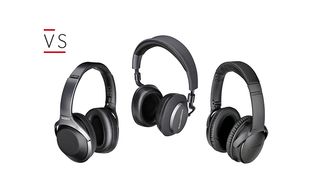Scenario one: you’re on the train home after a long day. Naturally, you’re squashed against other passengers, listening to the droning of the train (and of your fellow travellers).
You pull out your headphones and struggle to plug them into your phone before squeezing them up to your ears. What little music you can hear is drowned out by all the other sounds around you.
Scenario two: you’re on the train home after a long day. Naturally, you’re squashed against other passengers, but with your noise-cancelling headphones on all you can hear is your music. No fears about the cable getting caught on your neighbour’s coat either, because you’ve opted for wireless headphones.
If you’ve been caught too many times in scenario one, then it’s high time you got yourself a pair of noise-cancelling wireless headphones and enjoyed a bit of scenario two.
For our money, there are three over-ears worthy of your cash. But which one is best? Let’s take you through it.
The Challengers
Our trinity of noise-cancellation comes from three manufacturers: Bose, Sony, and Bowers & Wilkins.
Bose has, for years, been the go-to pair of cans to banish the hum of travel. The Bose QuietComfort 35s brought wireless functionality to the range for the first time in 2016, and a year later the (helpfully named) QuietComfort 35 II has replaced them.
Sony is in a similar boat - the Sony MDR-1000X wireless headphones from last year were an impressive proposition, but now they’ve been put out to pasture by the WH-1000XM2.
A fresh-faced contender, however, comes from B&W. Its PX headphones are the company’s first wireless headphones with built-in noise-cancelling, yet they knock it out of the proverbial park. This isn’t particularly surprising, as B&W’s other headphones are yet to drop below a four-star rating.
It used to be that noise-cancelling came with the compromise of less-than-optimal sound quality. Now, that’s not the case.
Our winner will be the one that can use all the high-tech tools at their disposal to give us all what we want: great sound from the drivers with as little sound as possible from the outside world.
MORE: How to choose the right pair of headphones
Features

The QuietComfort 35 IIs are the most obviously feature-laden. Not only do they have three levels of noise-cancellation (‘low’, ‘high’, or ‘off’), but they also come packed with Google Assistant integration.
What this means is, for Android users (or iOS users that have installed the Google Assistant app) the QuietComfort 35 II will ping whenever your phone gets a new notification or automatically read out upcoming calendar events.
Should you get a text or other online message, you can press the button on the left housing to have it read out to you and are then given the option to reply via your voice.
While not quite perfect yet – it won’t read out surnames, so you’ll have to figure out by context which of your two friends called ‘John’ is messaging you – it is a welcome addition and something we imagine we’ll be seeing more of in the future.
With regards to its noise-cancelling capabilities, the Bose is definitely a standout. The company has always been a potent performer when it comes to whisking away interfering noise, and it’s business as usual here.
Sitting in the office, without playing music, the rumble of fans or buzz of computers is eliminated effectively, and once the tunes start playing it’s hard to hear anything else.
On the right housing is the expected multifunction button to control playback and volume – two taps to skip forward, three to rewind, and so on.
And, like many headphones, there’s a companion app (Bose Connect) that lets you manage which devices your headphones are connected to, change the degree of noise cancellation and set a sleep mode.
MORE: Best noise-cancelling headphones 2017
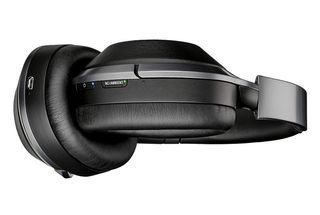
Sony’s headphones, by contrast, might not have all the bells and whistles when it comes to smart-assistant support, but the company has gone all-out with the smartest noise-cancelling software we’ve seen in any headphones.
The sophisticated features – such as the Sense Engine and Personal NC Optimiser we saw in the MDR-1000X – remain here. The latter fires out test tones to calibrate sound based on the earpad position and your ear shape.
Once that’s all set up, the headphones will connect to your smartphone and can, using the accelerometer, measure how fast you’re moving. This lets them adapt their noise cancellation accordingly to give you smarter adjustments.
If you’re sitting still in your office, the cancellation will be at its maximum. The moment you go for your lunchtime jog, though, the headphones will allow ambient sound to come through – ensuring you’re not hit by the passing car you didn’t hear because the noise-cancellation was still on maximum.
And since a lot of people take noise-cancelling headphones on flights, these headphones also take atmospheric pressure into consideration (through a sensor in the housing) to optimise sound quality at high altitudes.
MORE: Sony WH-1000XM2 review
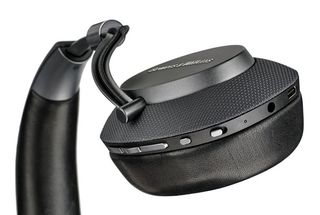
Bowers & Wilkins’ headphones sit in the middle ground. They have three noise-cancelling modes – Office, City, and Flight – that can be fine-tuned through the B&W Headphone app.
Set it to Flight and the noise-cancelling is at its strongest. When you’re walking through town, switch to City and you’ll still get the benefits of noise-cancelling - but with a greater awareness of your surroundings.
But should someone come up to you and start a conversation, you can lift up the earcup and the PXs will automatically pause the noise-cancellation and your music thanks to a proximity sensor built into each enclosure.
And should you take them off entirely the headphones will go into a standby mode to help conserve power. Put them back on and they ping out a couple of tones to signify they’ve woken up; playback will then recommence without you having to press a single button.
This is more sophisticated than Sony’s ‘Quick Attention’ function, where you hold your hand over the right headphone housing to cut out your music, letting you hear properly again.
It also feels more natural, and prevents you looking like you’re doing a bad impression of an FBI agent.
MORE: Best headphone deals - in-ear, over-ear, wireless
Build
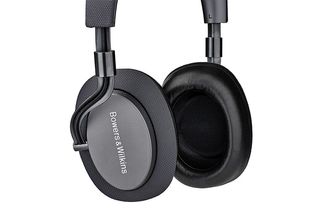
It’s no good having all the top-notch tech in the world if you want to take your headphones off after five minutes because they’re uncomfortable. Happily, none of our contenders are anywhere near that – but you are likely to have preferences.
Bowers and Wilkins’ PXs have, to our eyes, the classiest design. We like the industrial aesthetic from our space-grey review sample, but the optional (and much more blinging) Soft Gold finish looks snazzy too.
The headphones are constructed predominantly from lightweight aluminium and use what B&W refers to as a “ballistic nylon shell” to cover the outer earpads and the top of the headband.
MORE: Best headphones 2017
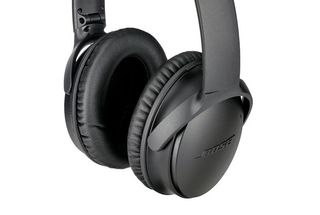
But they’re still the heaviest in our test, weighing 335g compared with the WH-1000XM2’s 275g or the QuietComfort 35 II’s 310g.
And subtle details like the way the headphone cables run down carefully constructed grooves and into each earpiece, as well as the raised texture of the company’s logo, are indicative of the quality that has been incorporated into these headphones' design.
They do a brilliant job at sealing your ear off from the rest of the world, but they do exert noticeably more inward pressure than their rivals.
MORE: Bose QuietComfort 35 II review
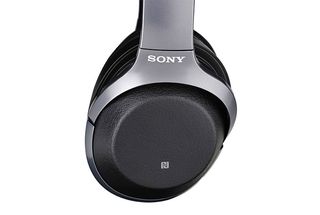
The Sony WH-1000XM2s are very slightly more comfortable. They sit securely on your head without feeling vice-like, and the texture of the outer earpiece covers – which you use for the headphones’ touch-activated playback controls – is a little rougher and more tactile.
But our favourites (when it comes to pure ear-massaging luxury) are the QuietComfort 35 IIs – and who would expect anything less? The clue is in their name.
They’re significantly lighter than the B&W PXs and have a gentler grip than the Sonys. The hinges on the earpads means they fold down nicely, easily small enough for your rucksack or handbag.
MORE: How to avoid buying fake headphones
Sound
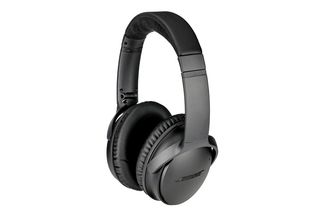
But let’s get down to brass tacks: how well does each pair of headphones perform when you’re pumping tunes through them? Each of these products have been awarded five stars, but that doesn’t mean they all sound the same.
The QuietComfort 35 II have a great ear for detail and insight no matter what you’re sending their way. The Beatles’ Let It Be, connected to a MacBook Pro, is delivered with a distinctly entertaining resonance to McCartney’s voice - and small elements of the song you might not otherwise be aware of are picked up on.
When McCartney comes up to the microphone to begin a line, these headphones commendably pick up the tiny sounds of his pursing.
With more aggressive tracks, these headphones don’t shy away from a challenge. Powerful bass notes are weighty and complex, capturing the lowest depths of the beat as a stick hits the skin of a drum all the way through to how the sound dissipates.
At the other end of the frequency range we hear a controlled and measured management of the high treble. The soaring vocalisations in Now We Are Free, from Hans Zimmer and Lisa Gerrard’s Gladiator motion-picture soundtrack, are far-reaching without any hint of brashness.
These headphones can take the changes in intensity in their stride. From the quiet drums and strings that rise up when the song begins to the rich tones of Lisa Gerrard’s idioglossia (her invented language) that dominate the piece, these headphones make smooth transitions. They allow you to really become immersed in your music.

And yet as good as these headphones are, they’re not top dog in this fight. Sony’s WH-1000XM2s have a fuller body and a better sense of dynamism, without sounding sluggish.
They can plummet deep enough to follow the bassline, but stop short of throwing off the rest of the presentation.
Wide-ranging dynamics at either end of the frequency scale are the bookends to an impressive level of detail, and the result is this musical package maintains your interest at all times and keeps you coming back for more.
Refined highs ensure the constant crashing of high-hat and cymbals during Idlewild’s A Modern Way Of Letting Go never threaten to sound edgy or bright - but there’s still enough of a spark to entertain.
The song’s over in a flash, but the Sonys allow you to savour every moment of it.
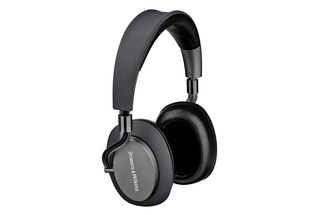
Bowers & Wilkins’ PXs bring their A-game to this battle too - those who crave transparency, detail and an even tonal balance (and really, who doesn’t?) won’t be disappointed.
And with aptX HD Bluetooth support, which can squeeze CD-quality audio out of compatible devices, they are a definite draw for the most audiophilic listener.
In fact, it’s difficult to call the PXs out on any aspect of their audio performance. Their presentation is different to the Sony WH-1000XM2s and Bose QC35 IIs and, if anything, even more appealing.
MORE: Bowers & Wilkins PX review

They paint music in a clear and clean manner, which helps where resolution and detail retrieval are concerned.
Poorer-quality recordings sound just that, but that’s the trade-off for the PX’s honest approach. Music sounds like it’s coming at you head-on rather from the sides, which seems to validate the design of those angled drivers.
The B&Ws follow the melancholic melody of Linkin Park’s Leave Out All The Rest with expert precision. The shift from fragile and emotional verse to explosive chorus is delivered with finesse and purpose – and no little bass heft.
Switching to the London Symphony Orchestra’s adaptation of Swan Lake reveals the PXs’ sophisticated, elegant side.
As the track reaches its climax, they do a great job of balancing the impact of the powerful rumblings of the percussion section, while all the individual elements such as the harp, violins and oboe are exquisitely rendered.
MORE: Best wireless Bluetooth headphones 2017
Verdict
So which is best? Ultimately… it depends what you’re looking for.
Those deep into the Android ecosystem might enjoy the Bose QuietComfort 35 IIs' synchronicity with their smartphone’s notifications. Similarly, we feel these are the most comfortable cans, even if they don’t necessarily sound the best.
The WH-1000XM2s sit in the middle, with great sound quality and some sharp noise-cancelling technology. There’s no denying they’re a quality bit of kit, and can best a lot of the competition out there – especially with the intelligent switching between noise-cancelling modes.
But right at the top, with the best balance of superb sonic chops and easy-to-use noise-cancellation, are the B&W PXs. They cross the finish-line just ahead of the Sonys thanks to their sense of timing and rhythm.
It’s a more accurate, articulate sound than the other headphones can provide, so if you’re looking for some noise-cancelling headphones that will bring out the best from your music, these are the ones we would be asking Father Christmas to put under our tree.
FIVE STARS
FOR: Lashings of detail; comfortable; impressive noise-cancellation; Google Assistant integration
AGAINST: Tough competition
VERDICT: Impressive noise-cancelling smart headphones that are great on the go
FIVE STARS
FOR: Transparent, detailed sound; excellent dynamics; impeccable sense of timing; clever, intuitive features; impressive noise-cancelling; good battery life; fine build
AGAINST: Nothing significant
VERDICT: The PXs are a fantastic package, boasting excellent sound quality, successful noise-cancelling and a smart design
FIVE STARS
FOR: Clarity; loads of detail; refined, smooth highs; punchy, confident lows; impressive noise-cancelling
AGAINST: Touchpad controls take a little bit of getting used to
VERDICT: Sony’s on a roll with its premium noise-cancelling headphones. Here’s another pair that’s easy to admire
